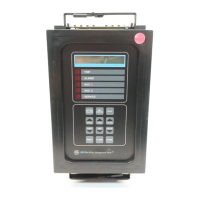GE Power Management 269Plus Motor Management Relay 2-
15
2 INSTALLATION GROUND CT INPUT
2
2.6 GROUND CT INPUT
All current carrying conductors must pass through a separate ground fault CT in order for the ground fault func-
tion to operate correctly. If the CT is placed over a shielded cable, capacitive coupling of phase current into the
cable shield during motor starts may be detected as ground current unless the shield wire is also passed
through the CT window. If a safety ground is used it should pass outside the CT window; see the installation
figures on the next page.
The connections to the 269Plus internal ground CT are made directly via #10 screws. The ground CT is con-
nected to Terminals 72 and 73 for a 5 A secondary CTs, or to Terminals 73 and 74 for GE Power Management
50:0.025A (2000:1 ratio) CTs, as shown in Figures 2–7: RELAY WIRING DIAGRAM (AC CONTROL POWER),
2–9: RELAY WIRING DIAGRAM (TWO PHASE CTs), and 2–10: RELAY WIRING DIAGRAM (DC CONTROL
POWER). The polarity of the ground CT connection is not important. It is recommended that the two CT
leads be twisted together to minimize noise pickup. If a 50:0.025A (2000:1 ratio) ground CT is used, the
secondary output will be a low level signal which allows for sensitive ground fault detection.
The GE Power Management 2000:1 CT is actually a 50:0.025A CT recommended for resistance
grounded systems where sensitive ground fault detection is required. If higher levels are to
be detected, a 5 A secondary CT should be used.
For a solidly grounded system where higher ground fault currents will flow, a 5 A secondary CT with a primary
between 20 and 1500 A may be used to surround all phase conductors. The phase CTs may also be residually
connected to provide ground sensing levels as low as 10% of the phase CT primary rating. For example, 100:5
CTs connected in the residual configuration can sense ground currents as low as 10 A (primary) without requir-
ing a separate ground CT. This saves the expense of an extra CT, however 3 phase CTs are required. If this
connection is used on a high resistance grounded system verify that the ground fault alarm and trip current set-
points are below the maximum ground current that can flow due to limiting by the system ground resistance.
Sensing levels below 10% of the phase CT primary rating is not recommended for reliable operation.
When the phase CTs are connected residually, the secondaries must be connected in such a way to allow the
269Plus to sense any ground current that might be flowing. To correctly display ground current and trip or
alarm on ground fault, the connection to the 269Plus must be made at terminals 72 and 73 as shown in Figure
2–7: RELAY WIRING DIAGRAM (AC CONTROL POWER) on page 2–8 and Figure 2–10: RELAY WIRING
DIAGRAM (DC CONTROL POWER) on page 2–11. These terminals are designed to accept input from a 5 A
secondary CT. The 269Plus must also be programmed for a 5 A secondary ground CT with the primary being
equal to the phase CT primary. This is done in Setpoints page 1.
NOTE

